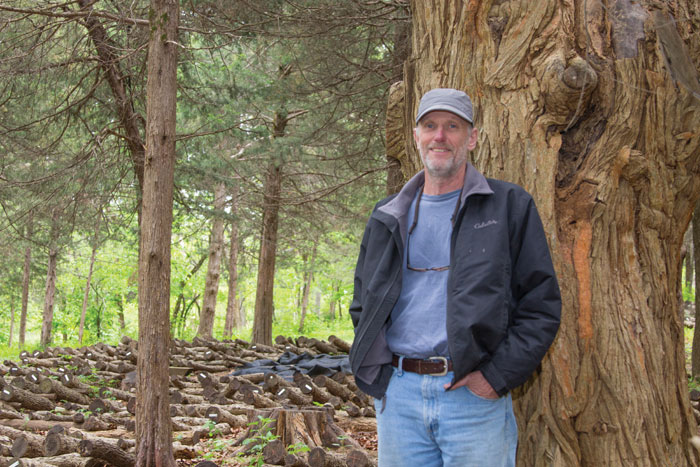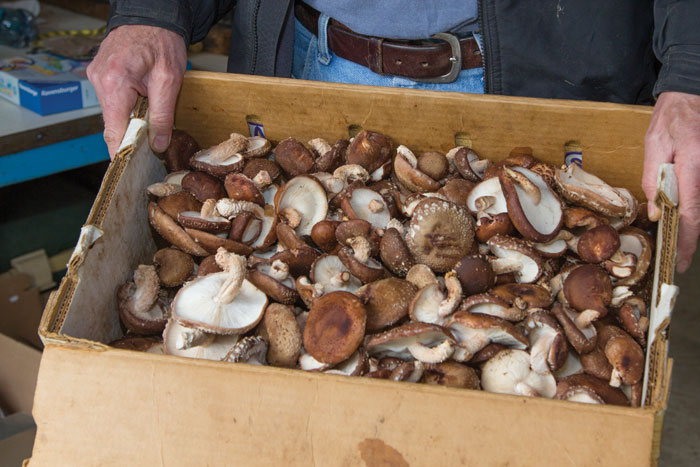| 2014 Q2 | story by SALLY ZOGRY | photos by STEVEN HERTZOG |

Most people would be hard-pressed to conjure up a mental image of a shitake mushroom farm, but according to Alan Terry, a peaceful patch of woods, and lots and lots of logs is about all there is to it.
Alan Terry has been cultivating shitakes on his 40-acre Oak Ridge Farm in Baldwin City for more than 25 years using a traditional Japanese method that his late wife first read about in a magazine.
“She saw an ad in a magazine about growing shitakes in oak logs,” says Alan. “I had never heard of shitake mushrooms. I don’t think a lot of people had back in the 80’s, but we had just finished building a house and had lot of oak log around the property.”

Alan Terry
The process of cultivating shitakes in oak logs starts with drilling one-inch holes into logs, and then plugging the holes with a shitake mycelium. The “inoculation sites” are then sealed with wax, and the logs are stacked in a shady spot – in Alan’s case, it’s a grove of cedars on his farm. About year and a half later, the mushrooms push aside the wax and emerge from the holes. Alan says the log method of cultivation is the hard way to grow shitakes, and that most commercial shitake farmers grow them on a synthetic substrate.
“People ask what I do, and sometimes I joke that I’m a log wrestler,” says Alan. “But I enjoy it, it gets me out in the woods. I like to get out there in the morning when it’s quiet the birds are singing. It’s very meditative.”
Alan, who also works in property management, has 3000-4000 logs on his farm that produce 1000-1500 pounds of shitakes a year. He sells the mushrooms to a number of local restaurants and occasionally sells at the Lawrence Farmer’s Market when he has a surplus. He says he finds the social aspect of the business satisfying.

Oak Ridge Farm
“You get to know the restaurants and the chefs,” says Alan. “It’s always nice when you deliver the first box of the season and the mushrooms look beautiful and everyone is happy to see you. Of course, it’s really the mushroom they’re happy to see, but you get a little of the rubbed-off glory.”
It is possible to speed up the cultivation time of the shitakes by soaking the logs in water overnight and covering them with a light plastic. This process will yield mushrooms in just a few weeks. For people who want to try their hand at growing shitakes using this method, Alan sells inoculated logs at The Holiday Farmer’s Market and at The Merc Co-op.
It’s fun for people to buy the log, watch the mushrooms grow and then eat them,” says Alan. “They make good gifts – I put a bow on them and sell quite a few at the holiday market.”

23 Comments
cialis voucher: Tadal Access – cialis price canada
https://tadalaccess.com/# how well does cialis work
where can i buy cialis online in canada: TadalAccess – truth behind generic cialis
cialis price cvs: originalcialis – cialis leg pain
https://tadalaccess.com/# cialis free trial voucher
does cialis lower your blood pressure: Tadal Access – where to buy cialis in canada
https://tadalaccess.com/# cialis daily dose
prices on cialis [url=https://tadalaccess.com/#]TadalAccess[/url] buy tadalafil no prescription
cialis dosage 20mg: TadalAccess – tadalafil professional review
tadalafil vidalista: TadalAccess – buy voucher for cialis daily online
https://tadalaccess.com/# cialis erection
tadalafil citrate: Tadal Access – generic cialis
https://tadalaccess.com/# buy cialis 20 mg online
We are highly skilled in external maintenance and regularly work with listed
buildings on the Grosvenor Estate and in Pimlico.
average dose of tadalafil: Tadal Access – tadalafil 10mg side effects
https://tadalaccess.com/# cialis free trial voucher
cialis tadalafil 10 mg: Tadal Access – п»їwhat can i take to enhance cialis
As a painter and decorator, you will be able utilise your creativity and be able to transform spaces through colour, texture, and design.
Over the counter antibiotics for infection: get antibiotics without seeing a doctor – cheapest antibiotics
online pharmacy australia: Pharm Au 24 – Pharm Au24
Licensed online pharmacy AU: Online drugstore Australia – pharmacy online australia
https://biotpharm.com/# Over the counter antibiotics for infection
how to get ed meds online: Ero Pharm Fast – ed online pharmacy